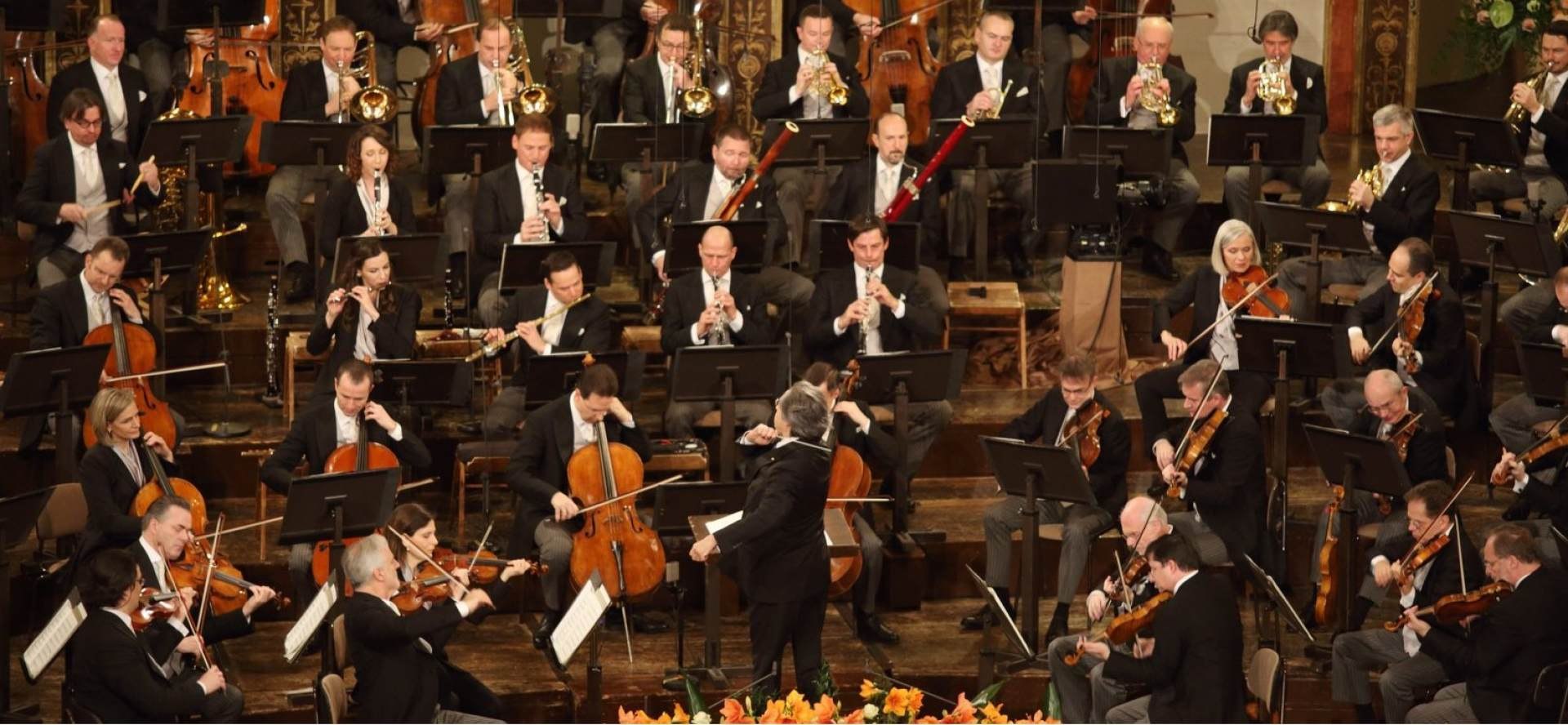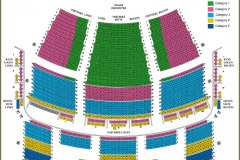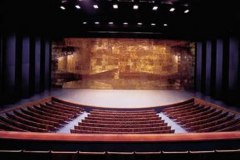Vienna Philharmonic
Mo | Tu | We | Th | Fr | Sa | Su |
There is perhaps no other musical ensemble more closely associated with the history and traditions of European classical music than the Vienna Philharmonic. Over the past 180 years, the orchestra has experienced and influenced musical history around the world.
The fascination that the orchestra has held since its foundation by Otto Nicolai in 1842 for prominent composers and conductors, as well as for audiences all over the world, is based upon the maintenance of a homogenous musical style which is carefully bequeathed from one generation to the next, as well as a unique history and administrative structure. The basic pillars are a democratic organization that places the entire artistic and management decision-making processes in the hands of the musicians, as well as a close symbiosis with the Orchestra of the Vienna State Opera. The statutes of the Vienna Philharmonic state that only musicians from the opera orchestra can become members of the Vienna Philharmonic.
The Vienna Philharmonic’s touring activities started at the beginning of the 20th century and have since taken the orchestra to all continents on the globe. In recent years, this has included regularly scheduled concerts in Germany, Japan, the USA and China.
The Vienna Philharmonic Orchestra Academy was founded in 2018. The Academy students are selected according to a strict, internationally-oriented audition process and trained at the highest level over a two-year course of study.
The Vienna Philharmonic has made it its mission to impart music’s humanitarian message into the daily lives and consciousness of its listeners. From the very beginning, the orchestra has displayed a strong social conscience, characterized by its commitment to individuals in need and the fostering of young musicians. To this day, the orchestra performs numerous benefit concerts and develops initiatives for the disadvantaged.
The Vienna Philharmonic gives more than forty concerts in Vienna every year, including the New Year’s Concert and the Summer Night Concert at Schönbrunn, both of which are broadcast around the world. The orchestra has also had an annual summer residency at the Salzburg Festival since 1922 and with more than fifty international concerts a year the Vienna Philharmonic is established as one of the world’s finest orchestras.
The orchestra has been the recipient of numerous prizes and awards over the course of its history.
Program and cast
25 and 27 July 2026
Artists
Ying Fang: Soprano
Nadezhda Karyazina: Alto
Wiener Singverein
Johannes Prinz: Chorus Master
Vienna Philharmonic
Gustavo Dudamel: Conductor
Programme
Gustav Mahler:
Symphony No. 2 in C minor — ‘Resurrection’
8 and 9 August 2026
Artists
Lang Lang: Piano
Vienna Philharmonic
Tugan Sokhiev: Conductor
Programme
Maurice Ravel:
Piano Concerto in G major
Claude Debussy:
La Mer — Trois esquisses symphoniques
Interval
Sergey Prokofiev:
Suite from the ballet Romeo and Juliet op. 64
(Compilation by Tugan Sokhiev)
15, 16 and 18 August 2026
Artists
Iwona Sobotka: Soprano
Marianne Crebassa: Alto
Michael Spyres: Tenor
Maharram Huseynov: Bass
Concert Association of the Vienna State Opera Chorus
Ernst Raffelsberger: Chorus Master
Vienna Philharmonic
Riccardo Muti: Conductor
Programme
Giuseppe Verdi:
Messa da Requiem
for four soloists, chorus and orchestra
22 and 23 August 2026
Artists
Augustin Hadelich: Violin
Vienna Philharmonic
Christian Thielemann: Conductor
Programme
Johannes Brahms:
Violin Concerto in D major op. 77
Interval
Symphony No. 1 in C minor op. 68
29 and 30 August 2026
Artists
Daniil Trifonov: Piano
Vienna Philharmonic
Andris Nelsons: Conductor
Programme
Sergey Rachmaninoff:
Piano Concerto No. 3 in D minor op. 30
Interval
Richard Strauss:
Don Juan op. 20 —
Tone poem after Nikolaus Lenau for large orchestra
Till Eulenspiegels lustige Streiche
(Till Eulenspiegel’s Merry Pranks) op. 28 —
Composed for Large Orchestra after the old Roguish Manner — in Rondo Form
Großes Festspielhaus
The plans for a Grosses Festspielhaus (Large Festival Hall), where the former archiepiscopal princely stables were located, were drawn up primarily by the architect Clemens Holzmeister; Herbert von Karajan also made many suggestions for the building project, in particular regarding the design of the theatre hall. Every effort was made and no expense spared so as to “insert” between the three-centuries-old façade of the former court stables and the Mönchsberg a theatre with an opera stage whose structure and technical equipment would still meet highest international demands after fifty years. Between autumn 1956 and the early summer of 1960, 55,000 cubic metres of rock were blasted away to create the relevant space. The building was largely financed from the state budget and as a result the Republic of Austria is the owner of the Grosses Festspielhaus.
The Grosses Festspielhaus was opened on 26 July 1960 with a festive ceremony and the performance of Der Rosenkavalier by Richard Strauss conducted by Herbert von Karajan. Even though the new stage was undoubtedly impressive in its dimensions, voices were raised even then expressing regret that it would hardly be suitable for staging operas by Mozart which require a more intimate setting. The ground plan of the auditorium is almost square, nearly 35 metres long and from the stalls as well as from the circle offers ideal acoustic conditions and sight-lines for 2,179 seats. The iron stage curtain weighs 34 tonnes and in the middle is one metre thick. The ground steel plates were created by Rudolf Hoflehner; the main curtain behind it was designed by Leo Wollner.
The décor for the concert hall was renewed in 1993 by Richard Peduzzi. Five bronze doors with handles designed by Toni Schneider-Manzell allow the public access from the Hofstallgasse. The façade is ornamented by a Latin inscription by the Benedictine monk Professor Thomas Michels (Order of St. Benedict):Sacra camenae domus concitis carmine patet quo nos attonitos numen ad auras ferat (The holy house of the muse is open for lovers of the arts, may divine power inspire us and raise us to the heights).
Mostly local materials were used for fitting out the Grosses Festspielhaus: the reinforced concrete columns in the entrance foyer were covered with the conglomerate rock removed from the wall of the Mönchsberg; the floor is made of Adnet marble. Low beam lighting in the sloping ceiling and panel dishes made of glass from Murano create a solid lighting design. Two sculptures created by Wander Bertoni in Carrara marble represent music and drama. The four large-scale paintings in the form of crosses on the theme Dreams with the Wrong Solutions, which were bought by the Austrian patron of the arts and collector Karlheinz Essl and made available on loan to the Salzburg Festival, are by the New York painter and sculptor Robert Longo (1993).
The interval hall adjoining the entrance foyer is largely based on the original ground plan of the archiepiscopal princely stables. The floor of green serpentine is new and contains mosaics of horses by Kurt Fischer. On the wall is a steel relief by Rudolf Hochlehner entitled Homage to Anton von Webern. Through the arch built by Fischer von Erlach one can look out onto the horse statue and fountain and the Schüttkasten which was acquired by the Salzburg Festival in 1987. A separate access on the left of the interval foyer leads via an escalator and steps to the underground car park for the old town centre of Salzburg.
The furnishings for a Patrons’ Lounge on the first floor of the Grosses Festspielhaus were financed by the American patrons of the arts Donald and Jeanne Kahn, who later became major sponsors of the Salzburg Festival. Since 1995 it has served as a reception area for patrons, sponsors as well as their guests and is also used for press conferences and various other functions in connection with the Salzburg Festival.
Specifications Grosses Festspielhaus
Stage width: 100 m Stage depth: 25 m
Proscenium width: 30 m
Proscenium height: 9 m
Five lifting podia, 18 x 3 m each; speed max. 0.25 m / sec.; loading capacity 20 tons each
Hydraulic stage machinery (double attachment of ABB)
Gridiron: 155 hoists with a loading capacity of 500 kg each, a third of them hydraulically driven and electronically controlled
Lighting: 825 adjustable electric circuits with a power of over 5000 watts each; digital light console; depot of around 2,000 individual lights
Electroacoustics: sound control board with 16 inputs, 16 main outputs and 4 auxiliary outputs; sockets for loudspeakers and microphones throughout the entire stage and auditorium.

 EN
EN DE
DE IT
IT FR
FR ES
ES RU
RU JP
JP RO
RO
 Seating plan
Seating plan 